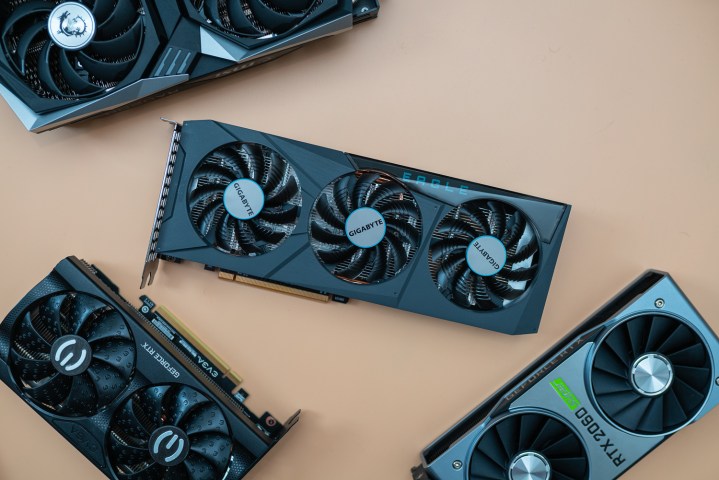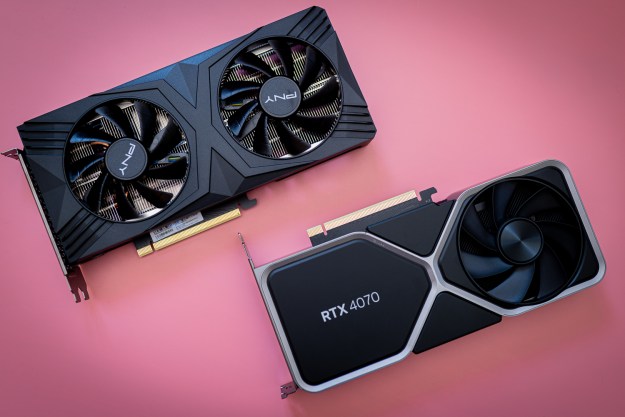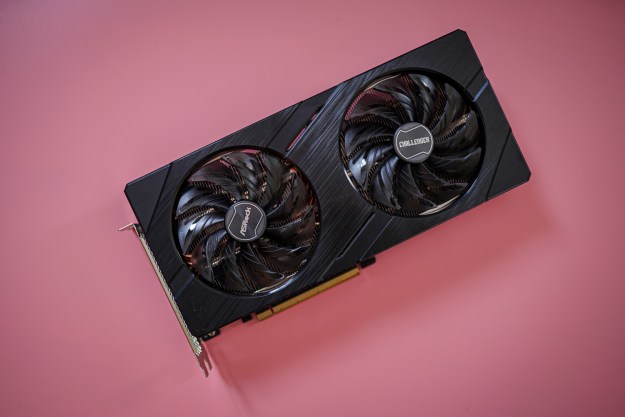The manufacturer’s suggested retail price (MSRP) for graphics cards continues to fall, with certain GPUs now coming within touching distance of reaching their original price tag.
3DCenter’s latest report confirms that prices for Nvidia GeForce RTX 30-series boards are now priced 14% over their MSRPs.

If you’re looking to equip your system with a GPU from AMD’s Radeon RX 6000 range, meanwhile, then you’ll have to pay 7% above MSRP.
The aforementioned figures cover the period between April 17 and May 8. In contrast, between March 27 and April 17, Team Green and Team Red cards were 19% and 12% over MSRP, respectively.
While Nvidia RTX 30 cards are still slightly more expensive than AMD’s offerings, this is the first time since January 2021 that the latter’s video cards have dropped below 10% over MSRP. Despite being a more costly option, the former’s range of RTX 3000 boards remains popular within the GPU industry.
As for 3DCenter’s chart, the report showcases the landscape of the GPU market in Germany, but we’ve seen stock levels and prices in other key regions like the U.S. and U.K. improve considerably in recent weeks.
In fact, the availability of GPUs in the report shows it’s reached its highest level since January 2021, which is a trend that has also been seen throughout other territories. That said, according to Tom’s Hardware, the mid-range segment of the GPU market has yet to fully recover.
Case in point: Both the Nvidia GeForce RTX 3070 and AMD Radeon RX 6800 cards are extremely hard to purchase, showcasing the fact that demand from the GPU shortage is largely being directed towards the more affordable video cards as opposed to the powerful, high-end market.
Furthermore, although prices are finally beginning to stabilize across the board, there are some GPUs that are still being subjected to inflated price points. These include the RX 6800, RX 6800 XT, RTX 3070, and RTX 3060 Ti, according to Tom’s Hardware.
VideoCardz highlights how, overall, the more powerful GPUs for enthusiasts cost 22% more on average over their MSRPs. The website also aptly points out how demand for these particular boards is stronger than ever before, with gamers opting to buy one now as opposed to doing so during the GPU shortage (when they were almost $1,000 to $2,000 more expensive).
Still, there are GPUs that are now available for MSRP, including the RTX 3080 Ti, RX 6900 XT, RX 6600 XT, RX 6500 XT, and RX 6400.
In some cases, cards like AMD’s Radeon RX 6900 have even dropped below the MSRP, with manufacturers and retailers aiming to sell existing stock in order to make way for the arrival of next-gen GPUs.

Demand for certain GPUs keeping prices high
A Redditor took a closer look at the current pricing for each card in 3DCenter’s report, of which Tom’s Hardware converted to U.S. dollars.
Notably, the user emphasizes the fact that “all cards with attractive MSRP still cost well above the average.”
Nvidia GeForce RTX 30 GPUs (prices in bold represent the MSRP for that card):
- RTX 3090 – 1,800 euros ($1,906) – $1,499
- RTX 3080 Ti – 1298 euros ($1,375) – $1,199
- RTX 3080 10GB – 899 euros ($952) – $699
- RTX 3070 Ti – 749 euros ($793) – $599
- RTX 3070 – 679 euros ($719) – $499
- RTX 3060 Ti – 590 euros ($625) – $399
- RTX 3060 – 420 euros ($445) – $329
- RTX 3050 – 348 euros ($369) – $249
AMD Radeon RX 6000 GPUs:
- RX 6900 XT – 1144 euros ($1,211) – $999
- RX 6800 XT – 929 euros ($984) – $649
- RX 6800 – 889 euros ($941) – $579
- RX 6700 XT – 599 euros ($634) – $479
- RX 6600 XT – 425 euros ($450) – $379
- RX 6600 – 359 euros ($380) – $329
- RX 6500 XT – 199 euros ($211) – $199
- RX 6400 – 182 euros ($193) – $159
With today’s expected launch of the RDNA 2 refresh that will make way for upgraded versions of some of the above cards (like the flagship RX 6900 XT), don’t be surprised if you see costs for current-gen Radeon 6000 boards decline even further in the near future.
Next-gen is nearly here
And don’t forget: Next-gen graphics cards are a few months away from hitting the market. Once Nvidia and AMD introduce these products, it’s a foregone conclusion that all the aforementioned GPUs — or for that matter, any GPU that currently exists — will undoubtedly reach or drop below their MSRPs.
AMD, for example, is reportedly working on a mid-range RDNA 3 version of the RX 6900 XT that is said to be priced between $399 and $499. Realistically, barring any availability problems, many will naturally choose to outfit their PC with the latter due to the huge price disparity for essentially the same product.
So, while it may be tempting to grab a board now due to the price drops, you probably won’t regret waiting just a few more months.
Editors' Recommendations
- Intel may fire the first shots in the next-gen GPU war
- GPU prices are back on the rise again
- You shouldn’t buy these Nvidia GPUs right now
- Nvidia just made GeForce Now so much better
- The most common GPU problems and how to fix them





